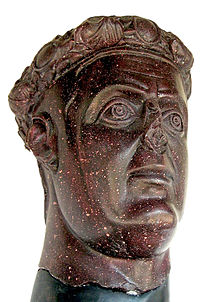Galerius Palace

The Galerius Palace in the ancient Felix Romuliana near Gamzigrad in the Timok Valley in Eastern Serbia is an archaeological excavation site and a UNESCO World Heritage Site . The ruins around seven kilometers southwest of Zaječar were first seen and described by August von Herder in 1835 . The attribution could be clarified with the excavations inside the walled palace in 1953, which uncovered an inscription with the name of the place Felix Romuliana. A portrait head made of porphyry reserved for the emperors confirmed the assumption that the Tetrarch Emperor Galerius (293-311) had the palace built as a retirement home. The facility was dedicated to his mother Romula, who was born nearby in the province of Dacia . On the nearby hill Magura, Galerius left and built his mother's tomb.
Felix Romuliana was described by Felix Philipp Kanitz as one of the largest and best-preserved Roman buildings in Europe and the completely preserved surrounding wall with 20 mighty, bastion-like towers up to 15 m high offers an impressive picture. In 2007, the Galerius Palace was included in the list of UNESCO - World Heritage added.
history
Galerius belonged to the government college of four emperors introduced by Diocletian , the tetrarchy . He was made Caesar (lower emperor) in 293 and resided in Milan, Nicomedia and Antioch. Galerius' main area of responsibility mainly included the Balkans. Here, in imitation of Diocletian, Galerius began to emphasize this position by means of a person-oriented representation of the ruler by erecting monumental buildings in the residences (including Galerius Arch in Thessaloniki ). From a military point of view, the years 299 to 311 marked expeditions against tribes north of the Danube. In 305, after the resignation of Diocletian, Galerius rose to become Augustus of the eastern half of the empire. As such, he sought to prevent the dissolution of the Roman tetrarchy in a series of civil wars since 306. Like Diocletian, Galerius persecuted Christians in his main area of responsibility with undiminished severity. Romula, Galerius' mother, was also a great admirer of the mountain deities.
Galerius was probably born on his father's estate ( villa rustica ) in Gamzigrad. Coin finds of Aurelian (270–275) and Probus (276–282) from the uncovered oldest building of the archaeological site lead to the conclusion that this villa rustica was built and used in the middle of the 3rd century. Romula probably continued to live in the villa rustica . The decision of Galerius to set up his palace here as a retirement home is connected with the vicennalia (twenty year jubilee of the throne) of the Augusti and the repeated decennalia (ten year jubilee of the throne) of the Caesares on November 20, 303. At the feast of the Tetrarchs in Rome, Diocletian announced his plan to abdicate and Galerius probably had planned to retire to his vicennalia 313 in the palace to be built. In addition to Felix Romuliana, the palace that first served his mother and, after his abdication, was also to become his retirement home, Galerius built his mother's tomb on the Magura hill. After his death in 311 Galerius was buried in a second tomb next to Romula. A tetrapylon also belonged to the tomb complex . After Galerius' death and the establishment of a burial place for him, all other construction activities were stopped and Felix Romuliana left.
In 380 Romuliana was repopulated and it developed into a rural vicus . Destroyed by the Huns in 441 , there were a few houses in the complex in the 5th and early 6th centuries. With the reign of Justinian I there was a stronger settlement and the construction of a large basilica with a baptistery. This was followed by destruction during Slavic invasions and in the 10th century a Slavic settlement that existed until the 12th century was established. After that, the place was abandoned and fell into disrepair.
literature
- Dragoslav Srejović : Felix Romuliana. The Ideological Testament of Emperor Galerius. In: Derselbe (Ed.): Roman Imperial Towns and Palaces in Serbia (= Gallery of the Serbian Academy of Sciences and Arts. Volume 73). Serbian Academy of Sciences and Arts, Belgrade 1993, pp. 28-53.
- Felix Romuliana. Galerius's Palace at Gamzigrad. In: Dragoslav Srejović (ed.): Roman Imperial Towns and Palaces in Serbia (= Gallery of the Serbian Academy of Sciences and Arts. Volume 73). Serbian Academy of Sciences and Arts, Belgrade 1993, pp. 118-147.
- Frank Kolb : Ruling ideology in late antiquity. Akademie Verlag, Berlin 2001, ISBN 3-05-003432-7 .
- Miloje Vasic: Felix Romuliana (Gamzigrad) - Palace and memorial of Emperor Galerius. In: U. Brandl, M. Vasić (Ed.): Rome's legacy in the Balkans. Late antique imperial villas and city complexes in Serbia . Verlag Philipp von Zabern, Mainz 2007, ISBN 978-3-8053-3760-1 , pp. 33-53.
- Gerda von Bülow: New investigations in the palace of the emperor Galerius - Felix Romuliana (Gamzigrad) . In: U. Brandl, M. Vasić (Ed.): Rome's legacy in the Balkans. Late antique imperial villas and city complexes in Serbia . Verlag Philipp von Zabern, Mainz 2007, ISBN 978-3-8053-3760-1 , pp. 54-57.
Web links
Remarks
Coordinates: 43 ° 53 ′ 57 " N , 22 ° 11 ′ 10" E


